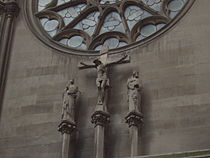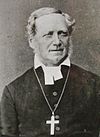- Christian cross
-
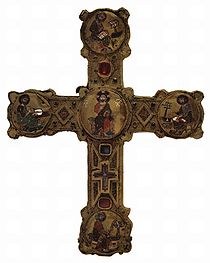 A reliquary in the form of an ornate Christian Cross
A reliquary in the form of an ornate Christian Cross
The Christian cross, seen as a representation of the instrument of the crucifixion of Jesus Christ, is the best-known religious symbol of Christianity.[1] It is related to the crucifix (a cross that includes a usually three-dimensional representation of Jesus' body) and to the more general family of cross symbols.
Contents
History of use of the symbol
Pre-Christian crosses
The cross-shaped sign, represented in its simplest form by a crossing of two lines at right angles, greatly antedates, in both East and West, the introduction of Christianity. It goes back to a very remote period of human civilization. It is supposed to have been used not just for its ornamental value, but also with religious significance.[2]
Some have sought to attach to the widespread use of this sign, in particular in its swastika form, a real ethnographic importance. It may have represented the apparatus used in kindling fire, and thus as the symbol of sacred fire or as a symbol of the sun, denoting its daily rotation. It has also been interpreted as the mystic representation of lightning or of the god of the tempest, and even the emblem of the Aryan pantheon and the primitive Aryan civilization.[2]
Another symbol that has been connected with the cross is the ansated cross (ankh or crux ansata) of the ancient Egyptians, which often appears as a symbolic sign in the hands of the goddess Sekhet, and appears as a hieroglyphic sign of life or of the living. In later times the Egyptian Christians (Copts), attracted by its form, and perhaps by its symbolism, adopted it as the emblem of the cross.[2] In his book, The Worship of the Dead (London, 1904), p. 226, Colonel J. Garnier wrote: "The cross in the form of the 'Crux Ansata'… was carried in the hands of the Egyptian priests and Pontiff kings as the symbol of their authority as priests of the Sun god and was called 'the Sign of Life'." [3]
In the Bronze Age we meet in different parts of Europe a more accurate representation of the cross, as conceived in Christian art, and in this shape it was soon widely diffused. This more precise characterization coincides with a corresponding general change in customs and beliefs. The cross is now met with, in various forms, on many objects: fibulas, cinctures, earthenware fragments, and on the bottom of drinking vessels. De Mortillet is of opinion that such use of the sign was not merely ornamental, but rather a symbol of consecration, especially in the case of objects pertaining to burial. In the proto-Etruscan cemetery of Golasecca every tomb has a vase with a cross engraved on it. True crosses of more or less artistic design have been found in Tiryns, at Mycenæ, in Crete, and on a fibula from Vulci.[2]
Early Christian use
See also: Early ChristianityDuring the first two centuries of Christianity, the cross may have been rare in Christian iconography, as it depicts a purposely painful and gruesome method of public execution and Christians were reluctant to use it.[1] The Ichthys, or fish symbol, was used by early Christians.[1] The Chi-Rho monogram, which was adopted by Constantine I in the 4th century as his banner (see labarum), was another Early Christian symbol of wide use.
However, the cross symbol was already associated with Christians in the 2nd century, as is indicated in the anti-Christian arguments cited in the Octavius[4] of Minucius Felix, chapters IX and XXIX, written at the end of that century or the beginning of the next,[5] and by the fact that by the early 3rd century the cross had become so closely associated with Christ that Clement of Alexandria, who died between 211 and 216, could without fear of ambiguity use the phrase τὸ κυριακὸν σημεῖον (the Lord's sign) to mean the cross, when he repeated the idea, current as early as the apocryphal Epistle of Barnabas, that the number 318 (in Greek numerals, ΤΙΗ) in Genesis 14:14 was interpreted as a foreshadowing (a "type") of the cross (T, an upright with crossbar, standing for 300) and of Jesus (ΙΗ, the first two letter of his name ΙΗΣΟΥΣ, standing for 18),[6] and his contemporary Tertullian could designate the body of Christian believers as crucis religiosi, i.e. "devotees of the Cross".[7] In his book De Corona, written in 204, Tertullian tells how it was already a tradition for Christians to trace repeatedly on their foreheads the sign of the cross.[8]
The Jewish Encyclopedia says[9]:
- The cross as a Christian symbol or "seal" came into use at least as early as the second century (see "Apost. Const." iii. 17; Epistle of Barnabas, xi.-xii.; Justin, "Apologia," i. 55-60; "Dial. cum Tryph." 85-97); and the marking of a cross upon the forehead and the chest was regarded as a talisman against the powers of demons (Tertullian, "De Corona," iii.; Cyprian, "Testimonies," xi. 21–22; Lactantius, "Divinæ Institutiones," iv. 27, and elsewhere). Accordingly the Christian Fathers had to defend themselves, as early as the second century, against the charge of being worshipers of the cross, as may be learned from Tertullian, "Apologia," xii., xvii., and Minucius Felix, "Octavius," xxix. Christians used to swear by the power of the cross (see Apocalypse of Mary, viii., in James, "Texts and Studies," iii. 118).
In contemporary Christianity
In Christianity the cross reminds Christians of God's act of love in Christ's sacrifice at Calvary—"the Lamb of God who takes away the sin of the world." The cross also reminds Christians of Jesus' victory over sin and death, since it is believed that through His death and resurrection He conquered death itself. They venerate it not as a material object seen in isolation but as the symbol of the sacrifice by which Christ saved them, as the instrument of Christ's triumph, according to Colossians 2:15 ("Having disarmed the powers and authorities, he made a public spectacle of them, triumphing over them by the cross"),[10] and "as the instrument of our God's saving Love".[11]
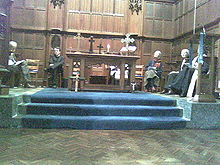 Christian crosses at a joint service for the Week of Prayer for Christian Unity.
Christian crosses at a joint service for the Week of Prayer for Christian Unity.
Roman Catholics, Eastern Orthodox, Oriental Orthodox, members of the major branches of Lutheranism, some Anglicans, and other Christians often make the Sign of the Cross upon themselves. This was already a common Christian practice in the time of Tertullian.[12]
The Feast of the Cross is an important Christian feast. One of the twelve Great Feasts in Eastern Orthodoxy is the Exaltation of the Cross on September 14, which commemorates the consecration of the basilica on the site where the original cross of Jesus was reportedly discovered in 326 by Helena of Constantinople, mother of Constantine the Great. The Catholic Church celebrates the feast on the same day and under the same name (In Exaltatione Sanctae Crucis), though in English it has been called the feast of the Triumph of the Cross.
Roman Catholic, Eastern Orthodox and Anglican bishops place a cross [+] before their name when signing a document. A cross [†] may also be placed before the name of a departed Christian when their name appears in print.
Exclusion
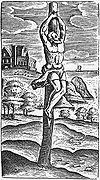 Crucifixion on a stake, one of the many forms presented in Justus Lipsius's De Cruce
Crucifixion on a stake, one of the many forms presented in Justus Lipsius's De Cruce
Jehovah's Witnesses do not accept the use of the cross as a symbol of Christianity. They claim that there no Biblical support for doing so and regard it as idolatry. They believe that the cross was widely used by worshipers of Tammuz, a Babylonian god, as his symbol. They believe that Jesus died, not on a two-beam cross, but on an upright stake, in accordance with the interpretation of the Greek word σταυρός (stauros). In classical Greek, this word meant merely an upright stake, or pale. Later it also came to be used for an execution stake having a crosspiece.[13] Although formerly, the Watchtower Society's publications had stated that Christ was crucified on a cross.
Members of the Church of Jesus Christ of Latter Day Saints believe that Jesus died on a cross, however "For us the cross is the symbol of the dying Christ, while our message is a declaration of the living Christ... the lives of our people must become the only meaningful expression of our faith and, in fact, therefore, the symbol of our worship."[14] Latter Day Saints do not place the cross on their buildings because the Bible does not mention the cross as a symbol for Christianity. Most temples will usually decorate one spire of the temple with a symbol of the Angel Moroni as an expression that the heavens have been reopened to man on earth.
Forms of the Cross
The cross is often shown in different shapes and sizes, in many different styles. It may be used in personal jewelry, or used on top of church buildings. It is shown both empty and in crucifix form, that is, with a figure of Christ, often referred to as the corpus (Latin for "body"), affixed to it. Roman Catholic, Anglican and Lutheran depictions of the cross are often crucifixes, in order to emphasize that it is Jesus that is important, rather than the cross in isolation. Large crucifixes are a prominent feature of some Lutheran churches, as illustrated in the article Rood. However, some other Protestant traditions depict the cross without the corpus, interpreting this form as an indication of belief in the resurrection rather than as representing the interval between the death and the resurrection of Jesus.
Crosses are a prominent feature of Christian cemeteries, either carved on gravestones or as sculpted stelas. Because of this, planting small crosses is sometimes used in countries of Christian culture to mark the site of fatal accidents, or to protest alleged deaths.
In Catholic countries, crosses are often erected on the peaks of prominent mountains, such as the Zugspitze or Mount Royal, so as to be visible over the entire surrounding area.
Forms of the Christian cross include:
Image Name Description 
Altar cross A cross on a flat base to rest upon the altar of a church. The earliest known representation of an altar cross appears in a miniature in a 9th-century manuscript. By the 10th century such crosses were in common use, but the earliest extant altar cross is a 12th-century one in the Great Lavra on Mt. Athos. Mass in the Roman Rite requires the presence of a cross (more exactly, a crucifix) "on or close to" the altar.[15] Accordingly, the required cross may rest on the reredos rather than on the altar, or it may be on the wall behind the altar or be suspended above the altar. 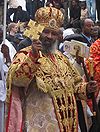
Blessing cross Used by priests of the Eastern Orthodox and Oriental Orthodox Churches to bestow blessings upon the faithful. 
Processional cross Used to lead religious processions; sometimes, after the procession it is placed behind the altar to serve as an altar cross. 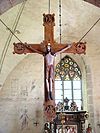
Rood Large crucifix high in a church; most medieval Western churches had one, often with figures of the Virgin Mary and John the Evangelist alongside, and often mounted on a rood screen 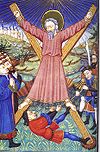
Andrew cross See, below, Saltire. 
Coptic ankh Shaped like the letter T surmounted by an oval or circle. Originally the Egyptian symbol for "life", it was adopted by the Copts (Egyptian Christians). Also called a crux ansata, meaning "cross with a handle". 
Anthony's cross See, below, Tau cross. 
Archiepiscopal cross A double-barred cross carried by an archbishop. 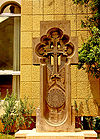
Armenian cross-stone (Khachkar) A khachkar (cross-stone) is a popular symbol of Armenians. Calvary cross Either a stepped cross (see below), or a Gothic-style cross mounted on a base shaped to resemble Calvary (the place where Christ was crucified, pictured as a hill), with the Virgin Mary and Saint John on either the base or crossarms. 
Canterbury cross A cross with four arms of equal length which widen to a hammer shape at the outside ends. Each arm has a triangular panel inscribed in a triquetra (three-cornered knot) pattern. There is a small square panel in the center of the cross. A symbol of the Anglican and Episcopal Churches. 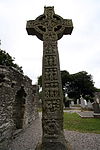
Celtic Cross Essentially a Latin cross, with a circle enclosing the intersection of the upright and crossbar, as in the standing High crosses. Consecration cross One of 12 crosses painted on the walls of a church to mark where it had been anointed during its consecration. 
Coptic cross The original Coptic cross has its origin in the Coptic ankh. New Coptic Cross This new Coptic Cross is the cross currently used by the Coptic Catholic Church and the Coptic Orthodox Church of Alexandria. It evolved from the older Coptic Crosses depicted above. A gallery of Coptic Crosses can be found here. 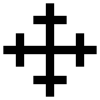
Cross crosslet This heraldic cross is made from four Latin Crosses arranged at right-angles to each other, with their tops pointing north, south, east and west, traditionally thought to represent the message of the cross going out to the four corners of the earth. The Cross crosslet, like the Jerusalem Cross, is a symbol for world evangelism of the Gospels, which gives an alternative name: Mission Cross. Another common interpretation is that it represents the four evangelists: Matthew, Mark, Luke and John.[16] 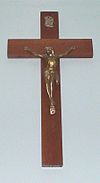
Crucifix A cross with a representation of Jesus' body hanging from it. It is primarily used in Catholic, Anglican, Lutheran, and Eastern Orthodox churches (where the figure is painted), and it emphasizes Christ's sacrifice— his death by crucifixion. 
Crux fourchette A cross with flared or forked ends (see illustration at Crosses in Heraldry). 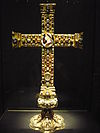
Crux gemmata A cross inlaid with gems. Denotes a glorification of the cross, this form was inspired by the cult of the cross that arose after Saint Helena's discovery of the true cross in Jerusalem in 327. Crux hasta A cross with a long descending arm; a cross-staff. 
Crux pattée A Greek cross with flared ends. Double cross. A cross with two crossbars. See Patriarchal cross. 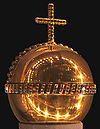
Globus cruciger Globe cross. An orb surmounted by a cross; used in royal regalia. 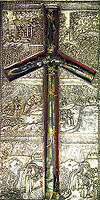
Grapevine cross Also known as the cross of Saint Nino of Cappadocia, who christianised Georgia. 
Greek cross With arms of equal length. One of the most common Christian forms, in common use by the 4th century. 
Gnostic cross Cross used by the early Gnostic sects. 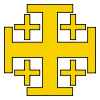
Jerusalem Cross Also known as the Crusader's Cross. A large cross with a smaller cross in each of its angles. It was used as a symbol of the Crusaders who fought against the Islamic forces. 
Latin cross Cross with a longer descending arm. Along with the Greek cross, it is the most common form. It represents the cross of Jesus' crucifixion. Living cross One of two possibilities: Either a natural cross made of living vines and branches. Or, a man-made cross with vines or plants planted at its base. In the all-natural version, it refers to the legend that Jesus' cross was made from the Tree of life. In the man-made cross with plants planted at the base, it contrasts the "new" Tree of Life (the cross) with the Book of Genesis Tree of Life. In both cases it shows Jesus' death (the cross) as a redemption for original sin (Tree of Life). 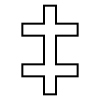
Lorraine cross Once with crossbars of equal length near the top and the bottom, now practically identical with the patriarchal cross 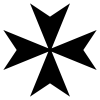
Maltese cross A Greek cross with arms that taper into the center. The outer ends may be forked. 
Marian Cross A term invented to refer to Pope John Paul II's combination of a Latin cross and the letter M, representing the Mary present on Calvary. 
Occitan cross Based on the counts of Toulouse's traditional coat of arms, it soon became the symbol of Occitania as a whole. 
Papal Cross A cross with three bars near the top. The bar are of unequal length, each one shorter than the one below. 
Patriarchal cross Also called an archiepiscopal cross or a crux gemina. A double cross, with the two crossbars near the top. The upper one is shorter, representing the plaque nailed to Jesus' cross. Similar to the Cross of Lorraine, though in the original version of the latter, the bottom arm is lower. The Eastern Orthodox cross adds a slanted bar near the foot. Pectoral cross A large cross worn in front of the chest (in Latin, pectus) by some clergy. 
Peter cross A cross with the crossbeam placed near the foot, that is associated with Saint Peter because of the tradition that he was crucified head down. 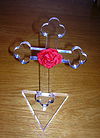
Rose Cross A cross with a rose blooming at the center. The central symbol to all groups embracing the Esoteric Christian philosophy of the Rosicrucians. 
Russian Orthodox cross (See Suppedaneum cross, below). 
Saltire or crux decussata An X-shaped cross associated with St. Andrew, patron of Scotland, and so a national symbol of that country. The shape is that of the cross on which Saint Andrew is said to have been martyred. Also known as St. Andrew's Cross or Andrew Cross. 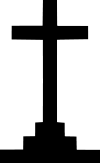
Stepped cross A cross resting on a base with three steps, also called a graded or a Calvary cross. 
Suppedaneum cross Also known as Crux Orthodoxa, Byzantine cross, Eastern cross, Russian cross, Slavic or Slavonic cross. A three-barred cross in which the short top bar represents the inscription over Jesus' head, and the lowest (usually slanting) short bar, placed near the foot, represents his footrest (in Latin, suppedaneum). This cross existed very early in Byzantium, and was adopted by the Russian Orthodox Church and especially popularized in the Slavic countries. 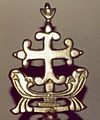
Saint Thomas Cross The ancient cross used by the Syrian Malabar Nasrani community of Saint Thomas Christians in Kerala, India.[17] 
Tau cross A T-shaped cross. Also called the Saint Anthony's cross and crux commissa. For further information on the forms in which the cross is represented, including its heraldric use, see the article Cross.
Unicode contains a number of cross symbols. The dagger symbol also represents the Christian cross. In Unicode, it is U+2020(†).
Gallery
Here are some examples of crosses:
-
Rock of Cashel cross
-
Cross of Sacrifice or War Cross
-
Cross in Valle de los Caídos, the highest cross in the world
-
The Millennium Cross in Skopje, Republic of Macedonia one of the biggest crosses in the world
See also
- Christian symbolism
- Cross burning
- Cross of All Nations
- Dispute about Jesus' execution method
- Intending cross
- Khachkar
- Market cross
- Rood screen
- Rood loft
- Roodmas
- Stauros
References
- ^ a b c Christianity: an introduction by Alister E. McGrath 2006 ISBN 1405109017 pages 321-323 [1]
- ^ a b c d Marucchi, Orazio. "Archæology of the Cross and Crucifix." The Catholic Encyclopedia. Vol. 4. New York: Robert Appleton Company, 1908 Retrieved 13 February 2010. Cf. "Various objects, dating from periods long anterior to the Christian era, have been found, marked with crosses of different designs, in almost every part of the old world. India, Syria, Persia and Egypt have all yielded numberless examples… The use of the cross as a religious symbol in pre-Christian times and among non-Christian peoples may probably be regarded as almost universal, and in very many cases it was connected with some form of nature worship" (Encyclopaedia Britannica (1946), Vol. 6, p. 753.
- ^ http://books.google.com/books?id=jYkE1F8H1TAC&printsec=frontcover&dq=Worship+of+the+Dead&hl=en&ei=b12vTragCarV0QHrz7HCAQ&sa=X&oi=book_result&ct=result&resnum=1&ved=0CC4Q6AEwAA#v=onepage&q=Cross&f=false
- ^ Octavius
- ^ Minucius Felix speaks of the cross of Jesus in its familiar form, likening it to objects with a crossbeam or to a man with arms outstretched in prayer (Octavius of Minucius Felix, chapter XXIX).
- ^ Stromata, book VI, chapter XI
- ^ Apology., chapter xvi. In this chapter and elsewhere in the same book, Tertullian clearly distinguishes between a cross and a stake.
- ^ "At every forward step and movement, at every going in and out, when we put on our clothes and shoes, when we bathe, when we sit at table, when we light the lamps, on couch, on seat, in all the ordinary actions of daily life, we trace upon the forehead the sign" (De Corona, chapter 3)
- ^ Jewish Encyclopedia
- ^ Aquinas, Summa Theologica, III, 25, art. 4, ad 1
- ^ The Veneration of the Precious and Life-Giving Cross
- ^ De Corona, chapter 3, written in 204.
- ^ Alexander Hislop, The Two Babylons
- ^ Gordon B. Hinckley (Ensign May 1975, 93)
- ^ General Instruction of the Roman Missal, 117
- ^ Cross Crosslet
- ^ http://nasrani.net/2008/02/29/analogical-review-on-st-thomas-cross-the-symbol-of-nasranis/
External links
- MSN Encarta (Archived 2009-10-31), "Cross"
- Philip Schaff, History of the Christian Church, Ch. 6th, "Christian Art: § 77. The Cross and the Crucifix"
- An Explanation of the Russian Orthodox Three-Bar Cross
- Variations of Crosses - Images and Meanings
Categories:- Christian symbols
- Cross symbols
- Christian terms
Wikimedia Foundation. 2010.

